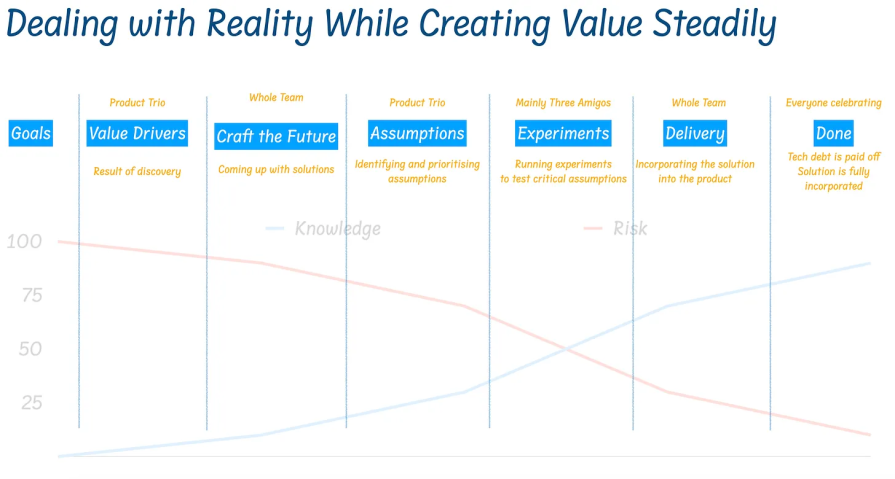Creating features isn’t why product teams exist. And yet, oftentimes people assume that it is.

If the CEO wants something, then that becomes the priority. If sales promise something, then the team has to deliver it. Or maybe an influential stakeholder has an insight, and then that becomes the direction.
But what about what customers truly need?
That’s the part that’s often forgotten. Teams get too busy juggling multiple things that distract them from creating what truly matters.
Product discovery helps you avoid costly mistakes by centering the customer in your development process. This way you can understand your customers and build products around their wants and needs.
Keep reading for a checklist that you can use within your product team to ensure your products align with your users.
For your product team to thrive, you need the following ten elements:
The term product trio became popular after Teresa Torres continuously mentioned it. You might also have heard it referred to as Three Amigos. Don’t worry—they mean the same thing.
A product trio explores the future to uncover value drivers. It helps you de-risk product ideas before implementing them and often consists of three different disciplines to ensure diverse perspectives.
A classic product trio will have:
The disciplines may vary according to your product and scenario. Ensure you have what’s needed to explore different ideas and even experiment with high-level solutions.
Now, you may wonder about the number three. It’s a good idea for a few reasons:
Have you heard the term stakeholder management? Let me be blunt, it sucks.
People hate being managed.
You’ll struggle to manage stakeholders who want more than you can ever deliver. Instead, aim for:
Product trios need to ensure alignment with business stakeholders. Without that, stakeholders will continuously knock on your door:

Product discovery requires continuous iterations. You cannot thrive without discipline. Try to develop a flow you can lean on. You should have a sense of:
The following image shows how I like structuring product discovery and delivery:

Nothing talks louder than results.
Management can be adverse to discovery because they often associate it with open-ended research that fails to deliver value. If you want to gain support, you need to share the discoveries you make.
Whenever someone asks me, “Why should we do discovery?” My answer is simple:
Discovery done right helps you avoid creating features nobody cares about.
Product discovery cannot guarantee value creation, but it does increase the chances of it. It also helps to cut bad investments short, which is often ignored by many companies.
As part of the product trio, you’ll make many decisions. You don’t need to share everything with everyone, which would be overwhelming, but you’d foster alignment and support by sharing:
Aligned with the previous item, you want to ensure stakeholders become aware of insights you collected from product experiments. This will help you gain trust and increase credibility.
Many companies do not encourage product experiments because they are unaware of the benefits they bring to the team. Take that as an opportunity to show them.
Here are a few examples:
When you do these things, you bring stakeholders closer to you. If you get them excited, product discovery will gradually gain support, so you won’t need to beg for time to run product experiments before implementing solutions.
How do you define solutions for problems you choose to solve? I generally see the following options:
The first two options often lead to suboptimal solutions, as well as features nobody needs. However the last one works well. Try this by:
From ideation, you should have potential solutions to benefit from the value driver you selected.
One thing that still shocks me is the unwillingness to explore multiple solutions for the same problem. Companies still “love” going all in on solutions instead of gradually exploring their potential.
A lot of people dislike ideation sessions because the results can be predictable. There can be a tendency to commit to the most conservative solution. That said, you can break out of this habit by exploring three solutions and measuring the results they create:
Assumptions are everywhere. It’s easy to ignore them because they hide in your subconscious. Common assumptions about products include:
Assumptions aren’t necessarily bad, but it’s a bad idea to implement solutions without testing critical assumptions.
The first step is to identify your assumptions. You can do that two ways:
Once you identify your assumptions, write them in a simple, testable way that validates progress. This might seem simple, but it can be tricky.
Let’s say you used my second suggestion of identifying assumptions. You realize your idea could go wrong because users won’t understand your value proposition and refuse to pay. Testing an assumption formulated this way is tricky. It’s better to test the behavior you want to see. Here are some examples:
You should only test assumptions that lack substantial evidence and are business critical—the others you could ignore.
Now, here comes the trick… remain curious. It’s not about proving yourself right; it’s about learning and uncovering hidden opportunities.
Another critical aspect is the testing speed. The faster you test it, the better.
Your first experiment should run in hours and give you direction. Then, you can run some experiments that take a few days. Once you’ve shaped enough, you’re ready to implement a solution.
When I created my first cohort last year, I had an assumption people would be interested in attending a live course with me. Here’s my experiment sequence:
Product discovery is more of an art than a science. Strive to learn from reality and adapt your practices. Don’t waste time crafting the first processes because that doesn’t exist. Reflect on what didn’t work and improve it.
Applying product discovery is a journey that takes time. Use the checklist to uncover opportunities to improve it. As you get into discovery, remember the importance of curiosity and courage.
Use every opportunity you have as a chance to learn. Collaboration beats processes. Always treat discovery as a collaborative game, not a coordinative one.
Featured image source: IconScout

LogRocket identifies friction points in the user experience so you can make informed decisions about product and design changes that must happen to hit your goals.
With LogRocket, you can understand the scope of the issues affecting your product and prioritize the changes that need to be made. LogRocket simplifies workflows by allowing Engineering, Product, UX, and Design teams to work from the same data as you, eliminating any confusion about what needs to be done.
Get your teams on the same page — try LogRocket today.

A practical five minute revenue estimation method to help product managers compare ideas, drop low impact features, and prioritize smarter.

A practical guide for PMs who want to stop being bottlenecks, delegate smarter, and lead teams effectively with a clear ownership framework.

Stop letting unreliable data block features. Treat data as inventory to track quality, ownership, and ship with confidence.

Learn why slide decks slow teams down and explore better tools like whiteboards, PRDs, and prototypes to improve collaboration and alignment.